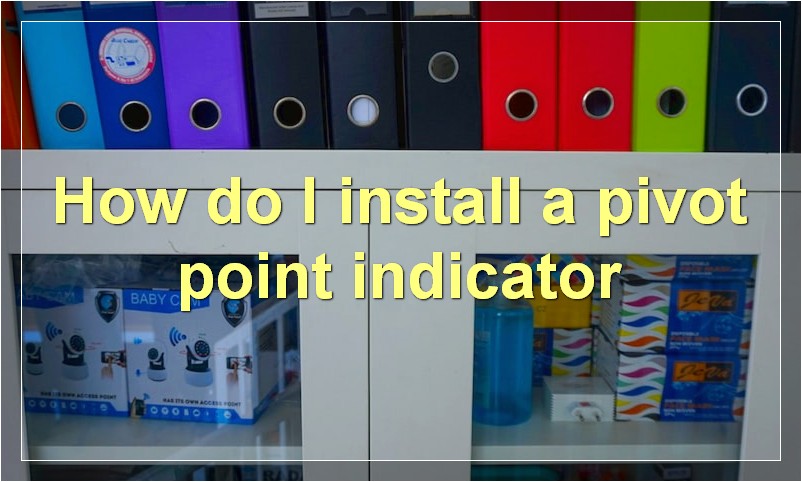If you’re a day trader or you’re interested in becoming one, then you need to know about pivot point indicators. These indicators are essential for making decisions about when to buy and sell.
What is a pivot point indicator
A pivot point indicator is a technical analysis tool that is used to determine the direction of the market. It is based on the premise that the market has a tendency to repeat itself and that price movements are not random.
The pivot point indicator can be used to identify market reversals, support and resistance levels, and to generate trading signals. It is a versatile tool that can be used in conjunction with other technical indicators to provide a complete picture of the market.
How is a pivot point indicator used

A pivot point indicator is used to help traders identify potential support and resistance levels in the market. By looking at the past price action of a security, traders can use pivot points to better predict where the security may find support or resistance in the future.
What are the benefits of using a pivot point indicator
Pivot point indicators are used by technical traders to identify potential support and resistance levels in the market. These levels are based on the previous day’s high, low and close prices, and can be used to predict where the market is likely to move in the future.
Pivot points can be used to identify both short-term and long-term trading opportunities. For short-term traders, pivot points can be used to identify potential entry and exit points in the market. For longer-term traders, pivot points can be used to identify major support and resistance levels that may impact the direction of the market over a period of time.
Pivot point indicators can be a valuable tool for all types of traders, as they can help to identify potential market turning points in advance. In addition, pivot points can also be used in conjunction with other technical indicators to confirm trading signals.
What are some of the best pivot point indicators
The best pivot point indicators are those that are reliable and easy to use. Some of the best pivot point indicators include the following:
-The Camarilla Pivot Point Indicator
-The Fibonacci Pivot Point Indicator
-The Woodie’s Pivot Point Indicator
-The DeMark’s Pivot Point Indicator
How do I choose a pivot point indicator
There is no definitive answer to this question, as different traders will have different opinions on which pivot point indicator is the best. However, there are a few things that you should consider when choosing a pivot point indicator, such as its accuracy, ease of use, and whether it is compatible with your trading platform. You may also want to read reviews of different pivot point indicators to see what other traders think of them.
How do I install a pivot point indicator

Assuming you would like a blog titled “How do I install a pivot point indicator”:
Installing a pivot point indicator is actually quite simple and only takes a few minutes. First, you’ll need to download the indicator from the internet or from your broker. Once you have the indicator, you’ll need to unzip it and copy it into your MT4 indicators folder. After that, you’ll need to restart your MT4 platform and then apply the indicator to your chart.
How do I use a pivot point indicator in MT4
A pivot point indicator is a technical tool that is used by traders to identify potential support and resistance levels in the market. The indicator can be used in any time frame, but it is most commonly used in the daily or weekly time frames.
The pivot point indicator works by taking the average of the high, low, and close prices from the previous period and then calculating the pivot point for the current period. The indicator will then plot the pivot point as a line on the chart.
The pivot point indicator can be used to trade a variety of different market conditions. In a bullish market, the indicator can be used to identify potential support levels that can be used to enter into long trades. In a bearish market, the indicator can be used to identify potential resistance levels that can be used to enter into short trades.
The pivot point indicator can also be used to trade breakout strategies. In a bullish market, traders can look for breakouts above the pivot point line and enter into long trades. In a bearish market, traders can look for breakouts below the pivot point line and enter into short trades.
The pivot point indicator is a valuable tool that can be used by traders to help them make better trading decisions. If you are looking to use this indicator in your own trading, there are many different ways that you can do so. Experiment with different settings and time frames to see what works best for you.
What are the settings for a pivot point indicator
A pivot point indicator is a technical analysis tool that is used to determine the overall trend of the market over different time frames. The pivot point itself is the point at which the market turns around and begins to move in the opposite direction. The indicator can be used to identify the direction of the market, as well as to predict future market movements.
The most common settings for a pivot point indicator are the daily, weekly, and monthly time frames. However, the indicator can also be used on other time frames, such as hourly or even minute charts. The indicator is typically set up with a period of 7 days, but this can be changed depending on the trader’s preference.
The indicator works by taking the average of the high, low, and close prices for a given period of time. This average is then used as the pivot point. The market is considered to be in an uptrend if the price is above the pivot point, and in a downtrend if it is below the pivot point. The indicator can also be used to identify support and resistance levels.
What are the different types of pivot point indicators
There are many different types of pivot point indicators, each with its own advantages and disadvantages. The most popular indicators are the Fibonacci Pivot Point Indicator, the Camarilla Pivot Point Indicator, and the Woodie’s Pivot Point Indicator. Each of these indicators has its own strengths and weaknesses, so it is important to choose the one that best suits your trading style.
Which pivot point indicator is the best
There are many different pivot point indicators available to traders, and choosing the best one can be difficult. Some factors to consider when choosing a pivot point indicator include the time frame that will be used, the type of trading that will be done, and the level of accuracy that is needed.

